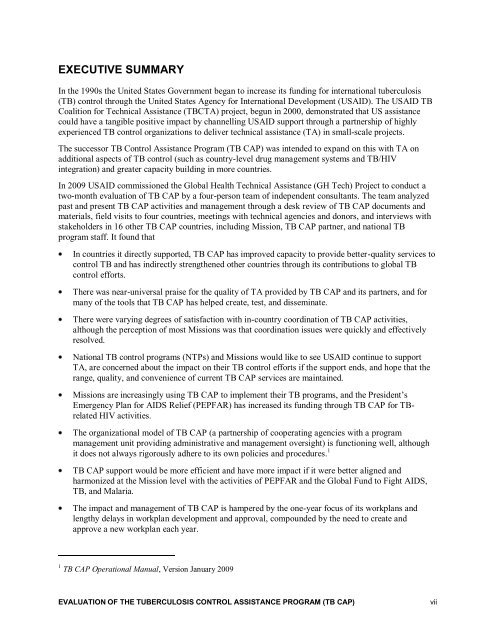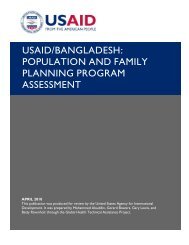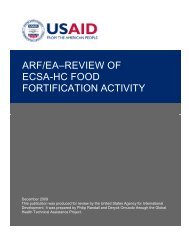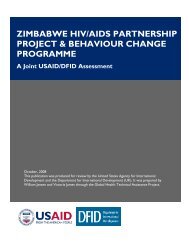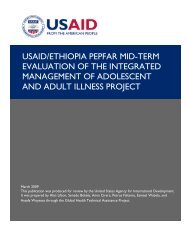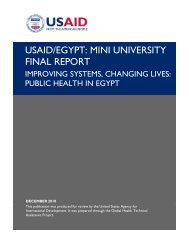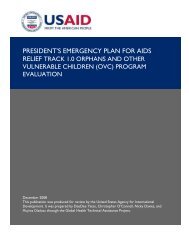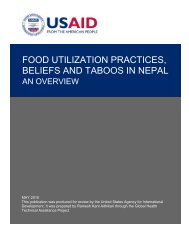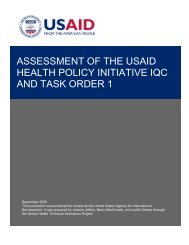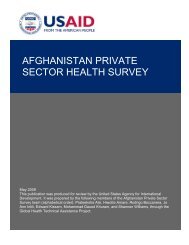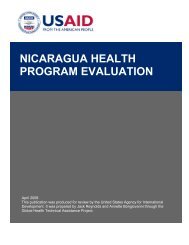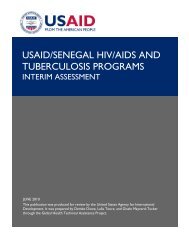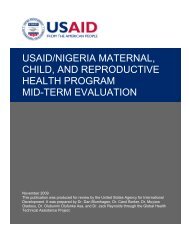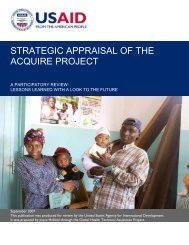Evaluation of the Tuberculosis Control Assistance Program (TB CAP)
Evaluation of the Tuberculosis Control Assistance Program (TB CAP)
Evaluation of the Tuberculosis Control Assistance Program (TB CAP)
Create successful ePaper yourself
Turn your PDF publications into a flip-book with our unique Google optimized e-Paper software.
EXECUTIVE SUMMARYIn <strong>the</strong> 1990s <strong>the</strong> United States Government began to increase its funding for international tuberculosis(<strong>TB</strong>) control through <strong>the</strong> United States Agency for International Development (USAID). The USAID <strong>TB</strong>Coalition for Technical <strong>Assistance</strong> (<strong>TB</strong>CTA) project, begun in 2000, demonstrated that US assistancecould have a tangible positive impact by channelling USAID support through a partnership <strong>of</strong> highlyexperienced <strong>TB</strong> control organizations to deliver technical assistance (TA) in small-scale projects.The successor <strong>TB</strong> <strong>Control</strong> <strong>Assistance</strong> <strong>Program</strong> (<strong>TB</strong> <strong>CAP</strong>) was intended to expand on this with TA onadditional aspects <strong>of</strong> <strong>TB</strong> control (such as country-level drug management systems and <strong>TB</strong>/HIVintegration) and greater capacity building in more countries.In 2009 USAID commissioned <strong>the</strong> Global Health Technical <strong>Assistance</strong> (GH Tech) Project to conduct atwo-month evaluation <strong>of</strong> <strong>TB</strong> <strong>CAP</strong> by a four-person team <strong>of</strong> independent consultants. The team analyzedpast and present <strong>TB</strong> <strong>CAP</strong> activities and management through a desk review <strong>of</strong> <strong>TB</strong> <strong>CAP</strong> documents andmaterials, field visits to four countries, meetings with technical agencies and donors, and interviews withstakeholders in 16 o<strong>the</strong>r <strong>TB</strong> <strong>CAP</strong> countries, including Mission, <strong>TB</strong> <strong>CAP</strong> partner, and national <strong>TB</strong>program staff. It found thatIn countries it directly supported, <strong>TB</strong> <strong>CAP</strong> has improved capacity to provide better-quality services tocontrol <strong>TB</strong> and has indirectly streng<strong>the</strong>ned o<strong>the</strong>r countries through its contributions to global <strong>TB</strong>control efforts.There was near-universal praise for <strong>the</strong> quality <strong>of</strong> TA provided by <strong>TB</strong> <strong>CAP</strong> and its partners, and formany <strong>of</strong> <strong>the</strong> tools that <strong>TB</strong> <strong>CAP</strong> has helped create, test, and disseminate.There were varying degrees <strong>of</strong> satisfaction with in-country coordination <strong>of</strong> <strong>TB</strong> <strong>CAP</strong> activities,although <strong>the</strong> perception <strong>of</strong> most Missions was that coordination issues were quickly and effectivelyresolved.National <strong>TB</strong> control programs (NTPs) and Missions would like to see USAID continue to supportTA, are concerned about <strong>the</strong> impact on <strong>the</strong>ir <strong>TB</strong> control efforts if <strong>the</strong> support ends, and hope that <strong>the</strong>range, quality, and convenience <strong>of</strong> current <strong>TB</strong> <strong>CAP</strong> services are maintained.Missions are increasingly using <strong>TB</strong> <strong>CAP</strong> to implement <strong>the</strong>ir <strong>TB</strong> programs, and <strong>the</strong> President’sEmergency Plan for AIDS Relief (PEPFAR) has increased its funding through <strong>TB</strong> <strong>CAP</strong> for <strong>TB</strong>relatedHIV activities.The organizational model <strong>of</strong> <strong>TB</strong> <strong>CAP</strong> (a partnership <strong>of</strong> cooperating agencies with a programmanagement unit providing administrative and management oversight) is functioning well, althoughit does not always rigorously adhere to its own policies and procedures. 1<strong>TB</strong> <strong>CAP</strong> support would be more efficient and have more impact if it were better aligned andharmonized at <strong>the</strong> Mission level with <strong>the</strong> activities <strong>of</strong> PEPFAR and <strong>the</strong> Global Fund to Fight AIDS,<strong>TB</strong>, and Malaria.The impact and management <strong>of</strong> <strong>TB</strong> <strong>CAP</strong> is hampered by <strong>the</strong> one-year focus <strong>of</strong> its workplans andlengthy delays in workplan development and approval, compounded by <strong>the</strong> need to create andapprove a new workplan each year.1 <strong>TB</strong> <strong>CAP</strong> Operational Manual, Version January 2009EVALUATION OF THE TUBERCULOSIS CONTROL ASSISTANCE PROGRAM (<strong>TB</strong> <strong>CAP</strong>)vii


